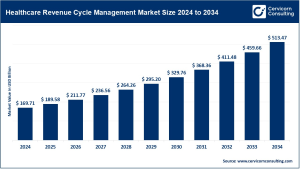Market Overview
The global infusion pump market was valued at roughly USD 11.34 billion in 2024 and is anticipated to reach around USD 21.58 billion by 2034, growing at a CAGR of 6.65%. Infusion pumps are crucial for delivering accurate doses of medications, nutrients, and fluids across hospitals, ambulatory care facilities, and home healthcare settings. Growth in the market is fueled by the rising prevalence of chronic diseases, increasing emphasis on patient safety, and the adoption of advanced smart technologies.
Get a Free Sample: https://www.cervicornconsulting.com/sample/2776
Key Market Trends
-
Intelligent Infusion Systems and Connectivity: Modern pumps now feature wireless, Bluetooth, and cloud-enabled monitoring, allowing real-time data sharing with healthcare providers. Integration with electronic health records (EHR) reduces errors and streamlines workflow.
-
Home and Ambulatory Infusion Therapy: Portable and wearable pumps support home-based care, especially for diabetes, oncology, and autoimmune patients. Usage in the U.S., Japan, and parts of Europe rose by over 40% by mid-2025, aided by telemonitoring solutions.
-
AI and Automated Infusion Systems: AI-powered closed-loop pumps adjust dosages based on patient needs, enhancing precision and personalization of therapy.
-
Focus on Smart and Wearable Pumps: Miniaturization and portability trends are driving adoption for long-term outpatient treatment, particularly among geriatric patients.
-
Regulatory and Safety Enhancements: Compliance with global standards and the inclusion of safety features, such as automated alerts and dose verification, are influencing product development and procurement decisions.
Market Drivers
-
Increasing Chronic Disease Prevalence: More than 500 million patients globally require regular infusion therapy for conditions like diabetes, cancer, and cardiovascular diseases, driving demand for reliable systems.
-
Technological Advancements: AI, machine learning, and remote monitoring have improved pump accuracy, efficiency, and safety.
-
Government Support and Healthcare Investments: Expansion of healthcare infrastructure in regions such as North America and Asia-Pacific supports the adoption of advanced infusion technologies.
-
Patient-Centric Care Models: The shift toward home healthcare, personalized therapy, and telemedicine adoption boosts demand for portable and wearable pumps.
Impact of Trends and Drivers
-
By Region: North America leads the market with a 38.3% share, driven by technologically advanced hospitals and early adoption of smart pumps. Asia-Pacific is the fastest-growing region, fueled by expanding healthcare access and rising chronic disease prevalence.
-
By Application: Oncology dominates with a 38.2% share, as infusion pumps ensure safe and precise chemotherapy delivery. Diabetes and chronic disease management are also seeing high uptake.
-
By Technology: Smart and automated infusion pumps hold a 37.9% share, especially in ICUs and surgical units, due to their ability to minimize errors and integrate with hospital IT systems.
Challenges & Opportunities
Challenges: High upfront costs, complex regulatory frameworks, and potential technical failures may slow adoption in emerging markets.
Opportunities: Rising demand for home healthcare, AI-enabled systems, and wearable pumps provides manufacturers with opportunities to expand into remote patient monitoring and chronic care solutions.
Future Outlook
The infusion pump market is expected to continue evolving over the next decade, driven by AI-based automation, telemonitoring, and wearable devices. A continued focus on patient safety, treatment personalization, and technology integration will shape adoption across hospitals, outpatient facilities, and home healthcare settings.
For a Detailed Overview, Contact Us: Cervicorn Consulting
